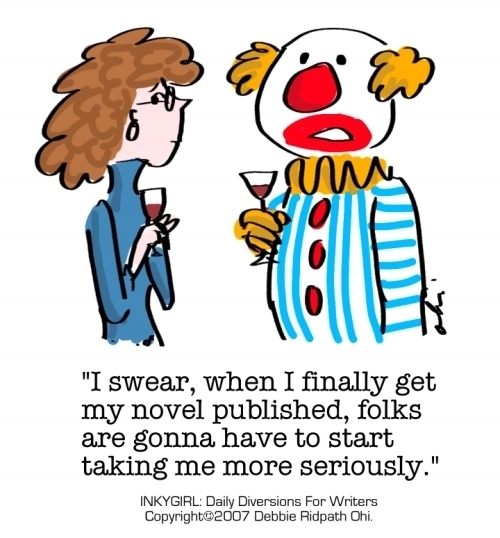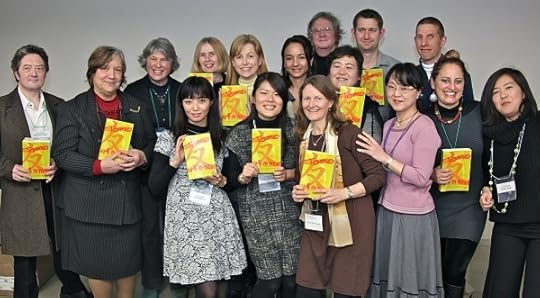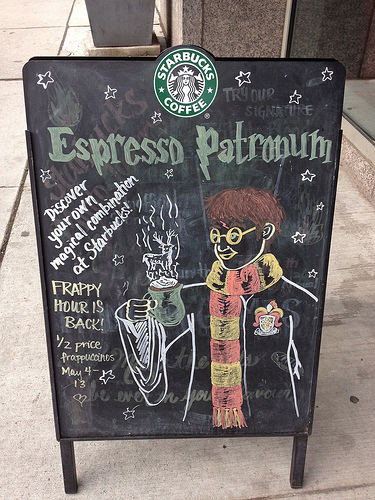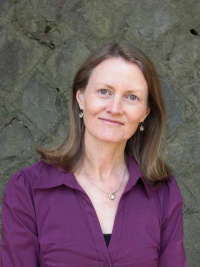Debbie Ridpath Ohi's Blog, page 114
May 26, 2012
On Writers and Elves: A Neil Gaiman Quote

This is one of my favourite Neil Gaiman quotes. Thanks to Neil for his permission to illustrate it. :-)
You can hear the original quote in this video in which he offers advice for young writers:
And if you haven't already seen the inspirational commencement speech he gave at the University of the Arts:
For more info about Neil Gaiman and his work, visit http://www.neilgaiman.com/







May 25, 2012
Children's Book Tributes at Starbucks in Toronto
Saw this outside a Starbucks on Yonge Street in Toronto (just south of Eglinton). Note the small text in the lower left corner: "We'll miss you, Maurice."
Just a few weeks ago, they had this sign:
One of these days I have to go in and meet the person responsible for these very cool signs. :-)







May 22, 2012
Video: The Power of Introverts in a World That Can’t Stop Talking
People who meet me at conventions sometimes think I'm an extrovert because I'm tend to be enthusiastic and talkative. The truth: I still consider myself an introvert. I'm the happiest and most productive when I'm in a quiet space. I far prefer one-on-one conversation than chitchatting within a large group.
Thanks to children's book author Mike Jung, who posted about Susan Cain's book on his Facebook Wall. The title appealed to me so strongly that I immediately investigated Susan's website, watched the video, and bought the e-book version:
QUIET: The Power Of Introverts That Can't Stop Talking.
LOVED this Tedtalk.
Make sure you listen to the end, where Susan talks about the irony of being an introvert, loving the writing process where she works alone, and then having to come out of her solitude to have to promote the book with public speaking. :-D







May 18, 2012
Comic: Feline Rejection
I'm posting some of my older comics here as I catalog and tag them in prep for a print book compilation. You can find my comics for writers on Inkygirl (http://inkygirl.com), Tumblr (http://inkygirl.tumblr.com) and Pinterest (http://pinterest.com/inkyelbows/comics-for-writers-inkygirl-com)








May 17, 2012
Comic: Apostrophe Abuse Breakup
I'm posting some of my older comics here as I catalog and tag them in prep for a print book compilation. You can find my comics for writers on Inkygirl (http://inkygirl.com), Tumblr (http://inkygirl.tumblr.com) and Pinterest (http://pinterest.com/inkyelbows/comics-for-writers-inkygirl-com)








May 15, 2012
Comic: Clown Writer
I'm posting some of my older comics here as I catalog and tag them in prep for a print book compilation. You can find my comics for writers on Inkygirl (http://inkygirl.com), Tumblr (http://inkygirl.tumblr.com) and Pinterest (http://pinterest.com/inkyelbows/comics-for-writers-inkygirl-com)








Comic: The Obsessed Writer
I'm posting some of my older comics here as I catalog and tag them in prep for a print book compilation. You can find my comics for writers on Inkygirl (http://inkygirl.com), Tumblr (http://inkygirl.tumblr.com) and Pinterest (http://pinterest.com/inkyelbows/comics-for-writers-inkygirl-com)








Writing & Illustrating A Picture Book For Simon & Schuster Books For Young Readers (Part 2: Brainstorming, Story Pitch, Thumbnail Assignment)
Continuing my series on writing and illustrating my very first picture book for Simon & Schuster Books For Young Readers....
ARCHIVES: Intro
(Please note: This series is about my own experience working with S&S BFYR and not meant to be a Definitive Guide. Your experience will differ, I'm sure, depending on your background and situation.)
Until I have a title set in stone, I'm going to refer to my picture book project as Picture Book X.
And here is what has happened so far:
I brainstormed picture book ideas.
I've been compiling picture book ideas for a while now, inspired by Paula Yoo's NaPiBoWriWee, Tara Lazar's PiBoIdMo and #KidLitArt's Picture Book Dummy Challenge. I've turned some of these into picture book manuscripts.
What I discovered: it's easy to come up with ideas for picture books. The challenge: to come up with picture book ideas that are different from anything else already out there.
This is one of the common misconceptions held by newbie picture book writers, I find: that their story is unique. I still consider myself a newbie picture book writer, by the way, so I speak from experience.
Child nervous about their first day at school but then finds out another child feels the same / makes new friends / discovers it's not so bad after all? Done.
Child has trouble making new friends because they are too shy / insecure / mean / stubborn / family just moved? Done.
Child loses a beloved object / pet / toy and is totally distraught but then formulates plan / enlists help / searches everywhere? Done.
Child having a horrible day where nothing goes right but then takes action & everything turns out ok? Done.
Child resents the fact that he is always overlooked / ignored and decides to do something about it? Done.
Child hates doing something that parents always want her to do so finds a way around it but then discovers why it was a good idea? Done.
Child resents older or younger sibling so decides to run away / get rid of sibling somehow but starts missing the sibling despite himself and reunites? Done.
...and so on.
I tried to figure out how to make my story stand out in the marketplace.
At this point, I can already imagine some of you shaking your fingers at me and saying, "Just focus on making a good story. Worry about the marketing/publishing part later."
However, I'm already assuming that having a good story is an essential. My end goal, however, is to not only get the book published but to have the book sell well. If the story is too much like others already out there, a publisher is less likely to want to take a risk on it. And if the book doesn't sell well, then the publisher is less likely to offer me more contracts.
So yes, there needs to be a good story.
But I also wanted to increase the chances that an editor would want to publish it by making it attractive from a marketing viewpoint, to do whatever I could to help an editor convince the publisher's sales team that the book was a good risk.
An aside: I've already gone through this several times with my novels for young people, in which various editors liked my story enough to take to the next step, but then the projects were nixed by sales/marketing. It's one reason I spent way more time in the plotting/outlining process for my current YA mss before starting to actually write it (and it got nominated for an SCBWI Sue Alexander "Most Promising For Publication Award"! It didn't win...but still! Now I just need to finish it).
I read many, many picture books.
Since the career-changing events of 2010, I've been immersing myself in the world of picture books. I have no children and hadn't really read many picture books since my nephews and nieces grew past that stage.
Once Simon & Schuster BFYR offered me my first picture book illustration contract, that all changed. I started going to the library and local bookstores every week to read as many picture books as I could. I read everything I could get my hands on -- old and new.
I looked at both the text and the illustrations, and how they enhanced each other. I didn't always like the picture books I read, but tried to analyze exactly WHY I didn't like them. And when I really enjoyed a picture book, then I'd reread it and ask myself similar questions: WHY did I like it?
I tried to figure out a unique spin.
At some point, I recall getting depressed about not being able to come up with a unique story idea. It seemed like ALL the basic story ideas have already been used! How on earth was I going to be able to come up with a new idea that a publisher would want?
So then I started looking at new releases. Obviously these publishers had faith in these books, so what was it about the stories that made the publishers willing to invest money into these projects? The answer: a unique spin. In almost every case, the basic story was enhanced with a framework made unique in either the setting, characters, voice, format or other aspect.
I realized that I needed to get my head into "pitch" mode.
When I last visited Simon & Schuster BFYR in NYC to talk about I'M BORED promotion, Justin asked me if I had any picture book stories to show him. I hesitated, saying that I had written about 25 picture book manuscripts but wasn't yet happy with any of them.
Justin interrupted my babbling excuses and suggested that I needed to change my mindset. Having worked with S&S BFYR on I'm Bored, I already had my foot in the door. Simon & Schuster Books For Young Readers was publisher. He was my editor. So how about I pick out 4-5 of what I considered my best stories and send them to him, even if I didn't think they were perfect yet?
I promised to send them very soon. Of course I was still paranoid about sending stories I considered early drafts, so I enlisted the help of my MiG Writers critique group for some feedback.
Then...I took a deep breath and send my stories to Justin.
Justin picked one he thought had the most potential. I'm very happy he picked the idea that he did; of all the stories I sent him, this is going to be the most fun to draw!
We had a phone meeting about my story, with editorial assistant Dani Young sitting in. It was a TRULY EXCELLENT phone meeting. I was all "omigod, you're absolutely RIGHT" and "YES! I love that idea!!" and Justin was all "it's all right there in your story" (I just hadn't seen it).
What Justin was able to do, which I hadn't, was to identify the essence of my picture book as well as see the potential of what it could be. AND he was able to communicate that to me.
By the end of the phone call, I was incredibly inspired and eager to get started.
THE NEXT STEP: I need to show my story visually, in thumbnails.
Justin asked me to forget about working on the text but just to focus on figuring out how to tell my story visually in very rough thumbnail sketches -- knowing that will help determine my text. I'm not going to worry about character sketches or detailed illustrations yet.
To do this, I've created a template which fits on an 8.5 x 11 sheet of paper. In case any of you would like to use it for your own picture book planning, I've provided a print-ready PDF version (click thumbnail below):
There seem to be many different templates for book dummies out there, but I wanted to make sure I was using one that Justin approved -- plus I'm printing out quite a few copies for my own use and want to make sure the format's the right one for this project. So I'll be using the template above to visually tell my story. Justin told that the endpapers are separate for a 32-page book, so I'm not going to worry about those for now.
I've done nearly a dozen versions so far (I suspect I will do many more revisions) and I've already been finding that working out a story this way is great for exposing bad pacing and other storytelling problems.
Even if you don't draw but are just writing a picture book story, I still recommend you try this method. Just use stick figures or a scribbled phrase (e.g. "Sam throws marmite at Emma" etc.).
Other resources you might find helpful:
Bob Staake's Picture Book Templates (though reader Michael Johnson had issues with that template and proposed a revision)
Tara Lazaar's Picture Book Layout Dummy
How To Mock Up A Picture Book, by Darcy Pattison
FAQ: Making A Picture Book Dummy, by Tina Burke
How To Make A Storyboard, by Uri Shulevitz







May 9, 2012
Writing & Illustrating A Picture Book For Simon & Schuster Books For Young Readers (Part 1: Intro)
I'm pleased to announce the launch of a new series of blog posts:

As some of you may already know, I'm writing and illustrating my very first picture book for Simon & Schuster Books For Young Readers. I'm going to be blogging about the process of creating my yet-untitled picture book, from start to finish, in Inkygirl. If you're curious about my blog posts about the creation of I'M BORED, new picture book by Michael Ian Black that I was asked to illustrate, I recommend you follow my I'M BORED Scrapbook. That blog also details how I started working with Simon & Schuster BFYR.
Because my book is still in its early stages, I won't be talking about its content at all -- not even its title, which has yet to be finalized.
Instead, I'm going to be talking about the process with a perspective that I hope will help aspiring picture book writer/illustrators. I also figure this blog post series may be of interest to those curious about what it's like to work with Simon & Schuster Books For Young Readers.
I'll be posting about the process, what I'm learning, what happens at various steps and what they mean, the people I interact with at S&S and what they do. I'll be sharing some of the templates I create for myself to help with workflow, plus give you a peek of what goes on inside Simon & Schuster BFYR later on in the process, after I've handed in my finals.
Keep in mind that this is going to be based on just one particular project and from one perspective (mine). Your book project may have been -- or could be -- very different, depending on the circumstances and the people involved.
My editor, Justin Chanda, has given me the go-ahead to blog about the process (thanks, Justin!). I worked with Justin on I'M BORED illustration discussions, but this will be the first time I've worked with him on story text.
I haven't yet been assigned an art director; the project is still in its very early stages.
There is no set schedule to this blog post series. I'll only post in the series if I have something useful or interesting to say. To make it easier to follow this particular thread, I'll tag related posts with "pbcreation." Whenever possible, I'll also be including related resources to help you find additional info on the topic, and will also be encouraging you all to share your own experiences.
I hope you'll join me! :-)
----
Header photo credits: My photo - Beckett Gladney, Justin's photo - Sonya Sones







Interview with Holly Thompson, editor of TOMO: Friendship Through Fiction (Stone Bridge Press) plus a giveaway
As I've mentioned earlier, I'm very excited to have my first YA short story included in Tomo: Friendship Through Fiction, a new teen anthology edited by Holly Thompson and published by Stone Bridge Press. Part of the sales proceeds will go to help teens affected by the 2011 Japan earthquake and tsunami.
Post a comment below for a chance to win a copy of the book!
-------------------
Holly Thompson was raised in New England and is a longtime resident of Japan. She is the author of the YA verse novel Orchard (Delacorte/Random House), which received the APALA 2012 Asian/Pacific American Award for Literature and is a YALSA Best Fiction for Young Adults Selection; the picture book The Wakame Gatherers (Shen’s Books); and the novel Ash (Stone Bridge Press). She recently edited Tomo: Friendship Through Fiction (Stone Bridge Press). She teaches creative and academic writing at Yokohama City University and serves as Regional Advisor for the Tokyo chapter of the Society of Children’s Book and Writers. Visit her website at www.hatbooks.com and her blog at http://hatbooks.blogspot.com.
How did you come to live in Japan?
My husband had been an exchange student in Japan and was eager to return when we met. I was a biology major at the time, and Japan wasn’t on my agenda, but we compromised and I taught biology in Massachusetts for a couple years then we moved to Japan. That was in the 80s--we stayed for three years and during that time, I began writing seriously.
Then, so that I could attend NYU’s creative writing program, we moved to New York and ended up staying there until 1998 when we moved back to Japan. We thought we’d stay for another three years or so, but here it is 2012, and we’re still here, our children have basically been raised here, and it is definitely home for us . . . though New England and New York are also home.
Please tell us about how Tomo: Friendship Through Fiction was born.
March 11, 2011 brought the triple catastrophe of earthquake, tsunami, and nuclear plant disaster to Japan. For me, having lived for many years in the coastal town of Kamakura, the brute force of the tsunami and the destruction it wreaked on towns was terrifying. I happened to be in the U.S. for readings and a conference that day, and watching from afar, while my family was in Japan, was agonizing.
Those days immediately afterward, I was in a deep fog, and in the middle of that fog author Greg Fishbone contacted me to ask what we could do and to share his ideas about a Kidlit for Japan auction. Greg woke me out of my stupor, astounded me with his energy and determination, and I knew that I, too, needed to act.
The first thing I did when I returned to Japan was sign up to volunteer with tsunami cleanup in Tohoku with the NGO Peaceboat. And the next thing I did was to put together my ideas for a benefit anthology of Japan-related YA fiction. My agent reacted with understanding and encouragement, and soon Stone Bridge Press had agreed to take on the project.
What kind of response have you received so far?
People have been enjoying the contributor interviews on the Tomo Blog, and reviewers that have received Tomo: Friendship Through Fiction have praised its depth and breadth. It is a full anthology with 36 stories, including 10 in translation. And we enjoyed March launch events in Tokyo, Boston and New York—see the events page on the Tomo Blog.
 Tomo contributors with the Boston Children's Museum Teen Ambassadors
Tomo contributors with the Boston Children's Museum Teen Ambassadors
Any specifics about how the funds will be used?
Funds raised through the sales of Tomo: Friendship Through Fiction will go toward NPOs or NGOs that are active in supporting teens in the earthquake and tsunami affected areas. To start with, proceeds from the sales of Tomo: Friendship Through Fiction will be donated to the Japan-based NPO Hope for Tomorrow which is active in providing educational funding, mentoring and foreign language support to teens in the hardest hit areas.
Was this the first time you've edited a fiction anthology?
I’ve edited university poetry and fiction anthologies, but this was my first time editing an anthology of fiction that would reach a wide audience. It was also my first time editing works in translation, and the process taught me so much.
Compiling and editing Tomo: Friendship Through Fiction was an enormous undertaking, particularly given the time constraints—we wanted the anthology to launch in time for the one-year anniversary of the earthquake. But I know that I will be a stronger writer and better editor of my own writing thanks to this experience. And I loved plunging deep into the work of other writers and playing a role in shaping and polishing the stories.
 Tokyo launch: Back row, L to R: John Paul Catton, Juliet Winters Carpenter, Deborah Iwabuchi, Margi Napper, Louise George Kittaka, Ann Slater, Charles De Wolf, Trevor Kew, Hart Larrabee Front Row, L to R: Arie Nashiya, Yuko Katakawa, Holly Thompson, Sako Ikegami, Fumio Takano, Leza Lowitz, Mariko Nagai
Tokyo launch: Back row, L to R: John Paul Catton, Juliet Winters Carpenter, Deborah Iwabuchi, Margi Napper, Louise George Kittaka, Ann Slater, Charles De Wolf, Trevor Kew, Hart Larrabee Front Row, L to R: Arie Nashiya, Yuko Katakawa, Holly Thompson, Sako Ikegami, Fumio Takano, Leza Lowitz, Mariko Nagai
Do you have any advice for authors considering editing a short story anthology for the first time?
Understand from the get-go that it will consume much more of your time than you can possibly anticipate! Have an angle that will make your anthology completely different from any anthology already on the market. Get writers on board and share your proposal with others for feedback before you approach an agent or editor. Plan as much as possible before you even start.
What was it like, working on TOMO? (any challenges? anecdotes to share?
The biggest challenge, as I’ve said, was the time constraint. Everything was rushed, from soliciting work, to making final selections, arranging for translators, editing, compiling the glossary and bios, copyediting and proofreading. It was an intense marathon project, but the authors and translators who contributed were wonderful to work with, and Stone Bridge Press has poured time, funds, energy and enthusiasm into this book. I feel so lucky to have had this opportunity.
When I sent "Kodama" to you, I half-expected a rejection because of the unusual format. What convinced you to include it in your anthology?
I love the fun journal format of “Kodama.” When I set out to do Tomo: Friendship Through Fiction, I knew from the start that I wanted the book to be open to various forms of fiction—prose, verse and graphic narrative. Many YA editors and publishers have fortunately been very open to and encouraging of innovation, and I think we will continue to see more and more uniquely expressive YA fiction forms.
 Please tell us about your YA novel, Orchards, which received the APALA 2012 Asian/Pacific American Award for Literature.
Please tell us about your YA novel, Orchards, which received the APALA 2012 Asian/Pacific American Award for Literature.
Orchards (Delacorte/Random House, 2011) is a novel in verse told in the voice of Kana, a bicultural Japanese and Jewish-American girl who is sent to spend the summer with relatives in Japan after the suicide of a classmate.
Kana addresses her former classmate, Ruth, as she struggles to make sense of what happened while adjusting to life in a Japanese farm village and coping with issues of her bicultural identity. While Orchards deals with tough topics such as bullying, depression and suicide, it is the story of a girl discovering compassion and the need to take positive action.
What are your current and upcoming projects? And where can people find out more about you?
I am now busy doing the final revisions for my next YA verse novel The Language Inside (Delacorte/Random House 2013), about a non-Japanese girl raised in Japan who has suddenly moved to the U.S. due to her mother’s illness. The book deals with communication on many levels, inner and outer identity, and, of course, language. My website is www.hatbooks.com and my blog where I write about life in Japan, travels in Asia and whatever catches my interest.
Anything else you'd like to say?
Thank you for sharing your story “Kodama” with Tomo: Friendship Through Fiction. I look forward to seeing the full-length work this leads to...hint, hint! And thank you for your enthusiasm for Tomo. The Tomo: Friendship Through Fiction anthology is all about helping teens in Tohoku by connecting readers to Japan. I hope that readers of this blog will enjoy all that Tomo has to offer and find their connection to Japan.
------
For more info about Tomo: Friendship Through Fiction, including interviews with all the contributors, see the blog at: http://tomoanthology.blogspot.com
















